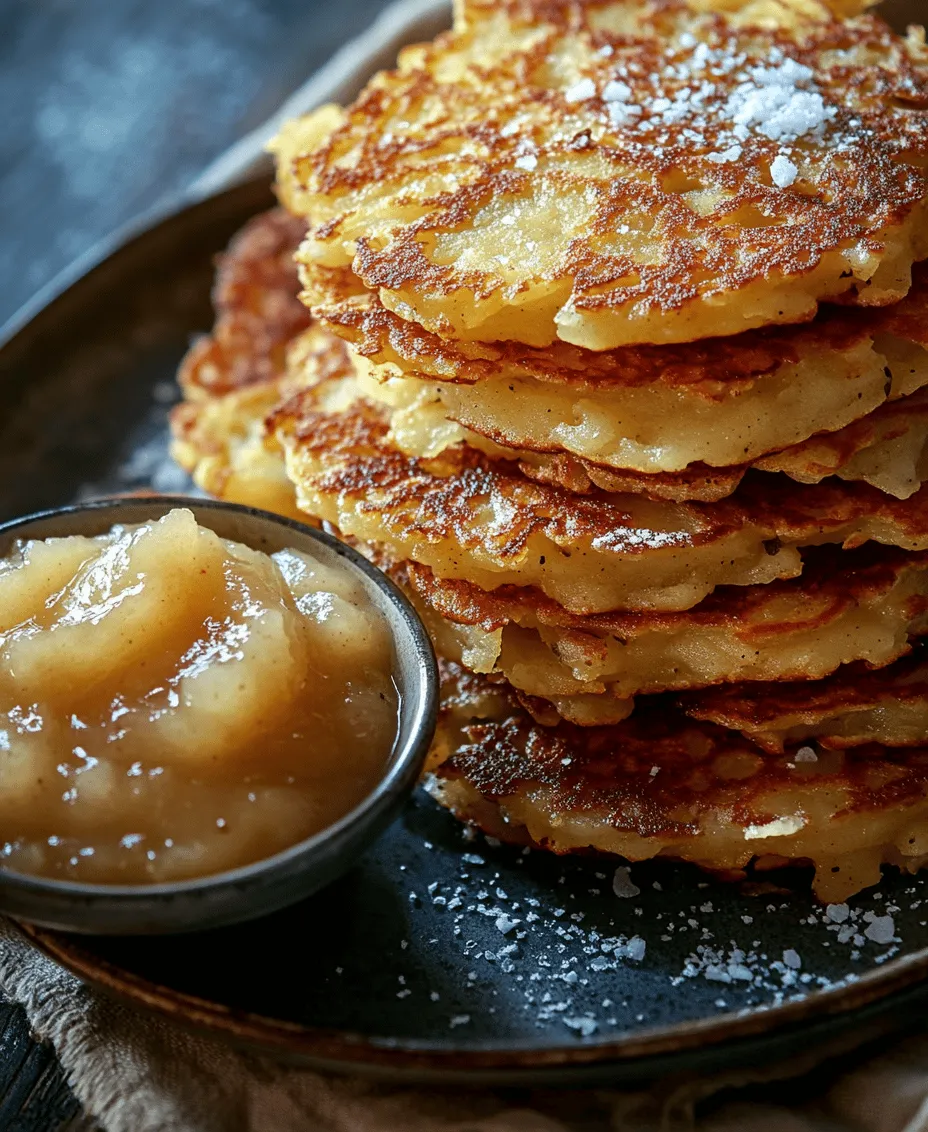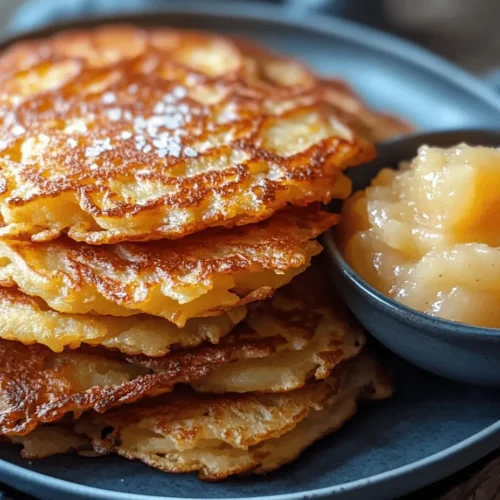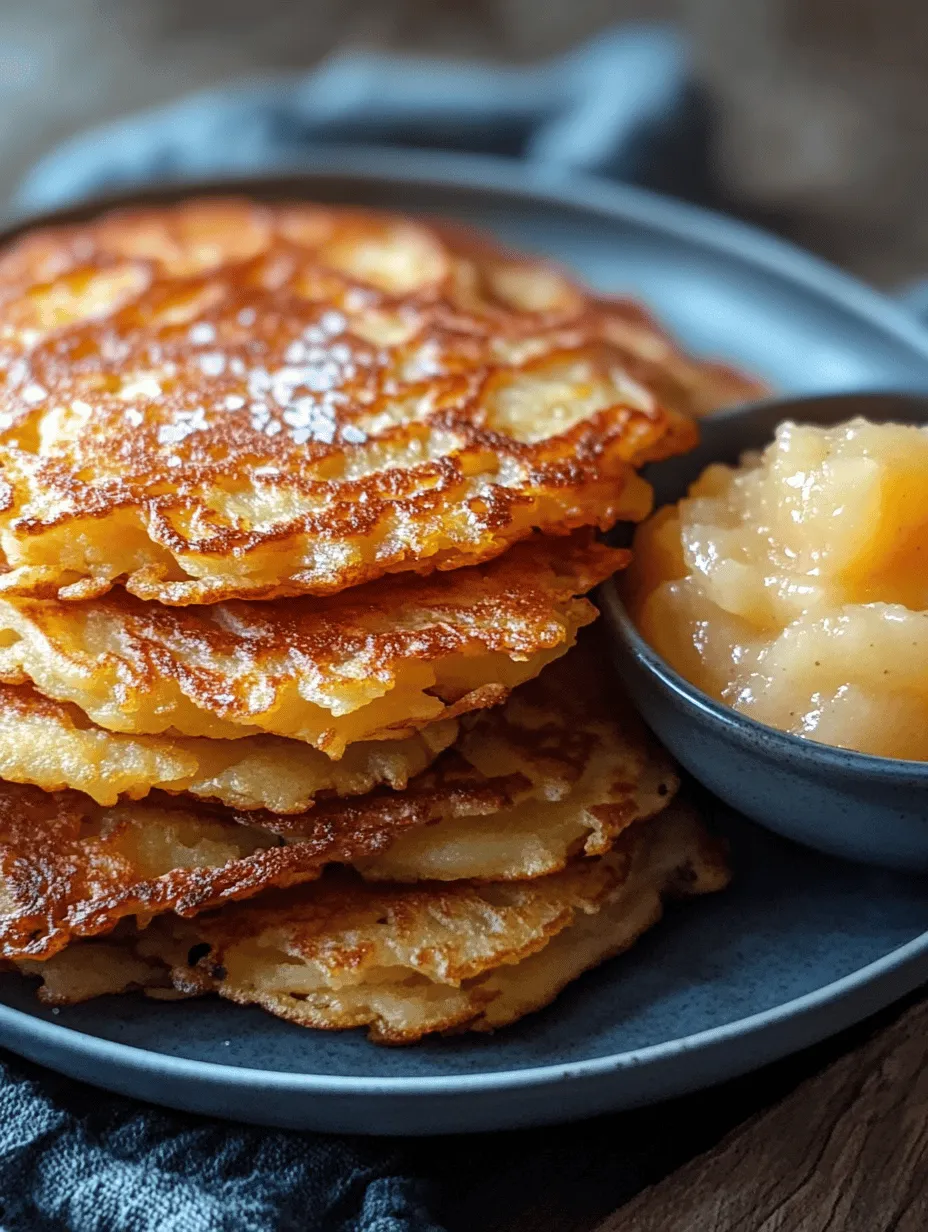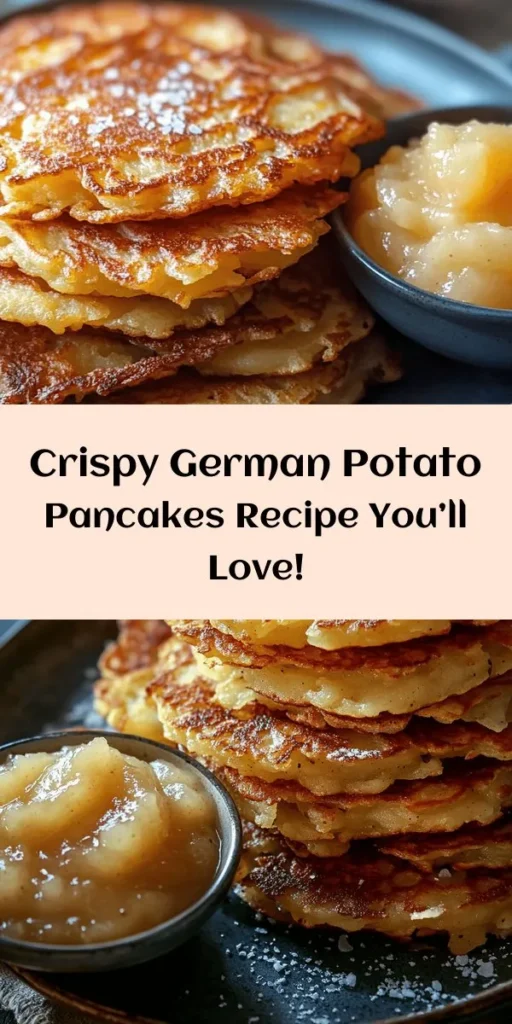Introduction
When it comes to the heart of German cuisine, few dishes embody tradition and comfort quite like Reibekuchen, or German potato pancakes. These crispy, golden-brown delights are more than just a popular street food; they hold a cherished place in the culinary heritage of Germany, often evoking memories of family gatherings and festive celebrations. Made primarily from potatoes, these pancakes are versatile and can be served as a savory dish or paired with sweet toppings, making them suitable for any meal of the day.
The cultural significance of potato pancakes in German cuisine extends beyond mere taste. They reflect the resourcefulness of home cooks who have perfected the art of transforming simple ingredients into something extraordinary. From bustling Christmas markets where they sizzle on hot griddles to cozy family dinners, Reibekuchen is a staple that brings people together, celebrating both heritage and flavor.
In this article, we aim to provide a comprehensive guide to making authentic German potato pancakes at home. We will delve into the rich history of Reibekuchen, explore regional variations, and walk you through the essential ingredients and preparation steps needed to achieve that perfect crispy texture. Whether you’re a seasoned chef or a novice in the kitchen, this guide will equip you with everything you need to recreate this beloved dish.
Understanding Reibekuchen
Origin and History of Potato Pancakes in Germany
The roots of potato pancakes can be traced back to the 17th century, when potatoes were first introduced to Europe from the Americas. Initially met with skepticism, the potato gradually became a dietary staple, particularly in Germany, where it was embraced for its versatility and nutritional value. Reibekuchen, as we know it today, gained popularity in the Rhineland and North German regions, becoming a beloved dish that reflects the agricultural heritage of the area.
Throughout the years, Reibekuchen has been celebrated not only for its taste but also for its adaptability. Traditionally, the pancakes are made by grating raw potatoes and mixing them with a few simple ingredients. This method showcases the humble potato in a deliciously crispy form, often enjoyed during festive occasions, local fairs, and family gatherings. The dish symbolizes the German ethos of simplicity and flavor, making it a timeless favorite.
Variations of Reibekuchen Across Different Regions in Germany
While the classic Reibekuchen recipe is relatively consistent, regional variations add unique twists that reflect local tastes and traditions. For instance, in the Rhineland, Reibekuchen are often served with applesauce, balancing the savory flavor with a sweet contrast. In contrast, Northern Germany might feature a more herbaceous version, incorporating fresh chives or parsley for added depth.
Some areas may also experiment with additional ingredients like grated carrots or zucchini, creating a colorful and nutritious twist on the traditional recipe. However, the core essence of Reibekuchen remains the same—crispy on the outside, tender on the inside, and bursting with the natural flavor of fresh potatoes. This adaptability has allowed Reibekuchen to maintain its status as a beloved dish, regardless of regional differences.
Importance of Using Fresh Ingredients to Achieve Authentic Flavors
To create truly authentic Reibekuchen, the quality of ingredients cannot be overstated. Fresh, high-quality ingredients are crucial for achieving the best flavor and texture. When it comes to potatoes, opting for Russet potatoes is highly recommended due to their high starch content, which contributes to the ideal crispiness and fluffiness of the pancakes. Fresh onions, typically used in the batter, add a depth of flavor that elevates the dish.
Moreover, using fresh herbs, if included, can enhance the overall flavor profile, providing a vibrant contrast to the starchy base. When preparing Reibekuchen, it’s essential to avoid pre-packaged or processed ingredients, as they can compromise the authenticity of the dish. By selecting fresh, seasonal produce, home cooks can ensure that their Reibekuchen are not only delicious but also a true representation of German culinary tradition.
Ingredients Breakdown
To prepare authentic German potato pancakes, you will need the following ingredients:
1. Russet Potatoes: The star of the dish, Russet potatoes are preferred for their starchy texture, which yields crispy edges and a fluffy interior. Their high starch content allows for better binding with other ingredients.
2. Onion: Fresh onions are finely grated and mixed into the batter to add a subtle sweetness and depth of flavor. They are a staple in the traditional recipe and help enhance the overall taste of the pancakes.
3. Flour: All-purpose flour acts as a binding agent, helping to hold the potato mixture together and providing structure. The right amount of flour is crucial; too much can lead to dense pancakes, while too little can result in a batter that falls apart during cooking.
4. Baking Powder: A small amount of baking powder is often added to the batter to promote a light and airy texture. It helps the pancakes rise slightly during cooking, giving them a fluffy interior.
5. Egg: The egg serves as a binding agent and adds richness to the pancakes. It helps to hold the grated potatoes and flour together, ensuring that the pancakes maintain their shape while cooking.
6. Salt and Pepper: These basic seasonings enhance the flavors of the other ingredients, ensuring that the pancakes are well-seasoned. A pinch of salt is essential for bringing out the natural taste of the potatoes.
7. Nutmeg (optional): While not always included, a dash of freshly grated nutmeg can add a warm, aromatic flavor to the batter. This spice is often associated with comfort food and can elevate the dish’s overall profile.
8. Serving Suggestions: Traditionally, Reibekuchen is served with applesauce or sour cream. The sweet and tangy applesauce complements the savory pancakes perfectly, while sour cream adds a creamy richness that balances the dish.
Preparation Steps for Authentic German Potato Panccakes
Creating authentic German potato pancakes involves a few key preparation steps that ensure the best texture and flavor. Let’s break down the initial steps, starting with the grating of potatoes and onions.
Grating Potatoes and Onions
The first step in preparing Reibekuchen is to grate the potatoes and onions. Using a box grater or a food processor with a grating attachment, finely grate the potatoes. It is essential to work quickly to prevent the potatoes from oxidizing and turning brown. Aim for a coarse texture that retains some moisture but is not overly mushy. The texture of the grated potatoes is crucial in achieving the desired crispiness when frying.
When grating the onions, you can use the same tool as the potatoes. The goal is to achieve a fine consistency that will blend seamlessly with the grated potatoes, allowing the flavors to meld together.
Techniques for Grating for the Best Texture
For the best results, consider the following techniques while grating:
– Use a Sharp Grater: A sharp grater will result in finer potato strands, which cook more evenly. If using a food processor, be cautious not to over-process, as this may lead to a paste rather than the desired texture.
– Grate Just Before Cooking: To preserve freshness and prevent browning, grate the potatoes and onions just before you plan to make the pancakes. This ensures maximum flavor and texture.
– Mix with Acid: To prevent oxidation, consider mixing the freshly grated potatoes with a little lemon juice or vinegar. This will keep them from turning brown without altering the flavor.
Importance of Removing Excess Moisture for Crispiness
One of the most crucial steps in making Reibekuchen is removing excess moisture from the grated potatoes and onions. If the mixture is too wet, the pancakes will steam instead of fry, resulting in a soggy texture.
To remove moisture, follow these steps:
1. Use a Clean Kitchen Towel: Place the grated mixture onto a clean kitchen towel or cheesecloth. Gather the edges and twist to form a pouch. Squeeze out as much liquid as possible.
2. Let It Rest: After squeezing, let the mixture sit for a few minutes. This allows any remaining moisture to settle at the bottom, which can be discarded.
3. Check for Dryness: The grated potatoes should feel slightly dry to the touch. If they still feel wet, repeat the squeezing process until you achieve the desired dryness.
By following these steps, you ensure that your Reibekuchen will be perfectly crispy, providing the satisfying crunch that makes this dish so beloved.
As you embark on this culinary journey to create authentic German potato pancakes, rest assured that each step you take brings you closer to a dish that is both rich in flavor and steeped in tradition. The following sections will guide you through the complete cooking process, ensuring that your homemade Reibekuchen captures the essence of this iconic recipe.

Mixing the Ingredients
To create the perfect batter for authentic German potato pancakes (Reibekuchen), the mixing process is crucial. Start by gathering your prepped ingredients: grated potatoes, finely diced onions, eggs, flour, salt, and pepper. The right balance of these ingredients will ensure a flavorful and cohesive mixture that holds together during cooking.
Begin by placing the grated potatoes in a large mixing bowl. To prevent oxidation and maintain their bright color, work quickly. Add the finely chopped onions directly into the bowl with the potatoes. The onions not only provide a subtle sweetness but also enhance the overall flavor profile of the pancakes.
Next, crack two large eggs into the mixture. The eggs act as a binding agent, helping to hold the batter together. Sprinkle in about half a cup of all-purpose flour, which will give the pancakes structure and a tender texture. Season generously with salt and freshly ground black pepper to taste. Mix all the ingredients thoroughly, ensuring that the flour is well incorporated and there are no dry clumps.
Combining the Potato and Onion Mix with Egg and Dry Ingredients
When combining the potato and onion mix with the egg and dry ingredients, it’s essential to do so gently to avoid mashing the potatoes too much. Use a spatula or wooden spoon to fold the ingredients together until they are just combined. The goal is to maintain the integrity of the potato shreds for a delightful texture in the final product.
As you mix, pay attention to the consistency of the batter. It should be thick enough to hold its shape when scooped onto the frying pan but not so dense that it becomes heavy. If you find the mixture is too dry, you can add a splash of water or an additional egg to achieve the desired consistency. Conversely, if it’s too wet, a little more flour can be added.
Tips on Achieving the Right Batter Consistency
Achieving the perfect batter consistency is a key factor in making delicious Reibekuchen. Here are some tips to help you get it just right:
1. Use Fresh Potatoes: Freshly grated potatoes yield the best results. Older potatoes may have a higher moisture content, which can affect the batter’s texture.
2. Drain Excess Moisture: After grating the potatoes, it’s beneficial to let them sit for a few minutes and then squeeze out any excess moisture using a clean kitchen towel. This removes extra water that could make the batter runny.
3. Adjust Consistency Gradually: If you’re unsure about the batter’s thickness, start with less flour and gradually add more until you find the right balance. Remember, the mixture should be thick enough to form patties but not so thick that it becomes dense.
4. Test a Small Batch: Before frying the entire batch, cook one test pancake to judge the flavor and texture. This allows you to make any necessary adjustments before committing to the whole mixture.
Cooking Techniques
The cooking techniques for Reibekuchen are vital to achieving that ideal crispy exterior while keeping the inside tender and flavorful.
Optimal Frying Temperatures and Oil Choices
To fry Reibekuchen perfectly, it’s important to maintain the right oil temperature. Preheat your frying pan over medium-high heat and add a generous amount of oil. A combination of vegetable oil and butter is ideal for flavor and heat tolerance. The oil should be hot enough that a small drop of batter sizzles upon contact. Aim for a frying temperature between 350°F and 375°F (175°C to 190°C).
Choosing the right oil is also crucial. Neutral oils like canola or sunflower oil work well due to their high smoke points. If you prefer a richer flavor, consider using ghee or clarified butter, which can withstand higher temperatures without burning.
Tips on Frying for Crispiness: Avoiding Overcrowding the Pan
One of the most common mistakes when frying potato pancakes is overcrowding the pan. When too many pancakes are added at once, the temperature of the oil drops, leading to soggy, greasy pancakes rather than the desired crispy texture.
To prevent this, fry in batches, giving each pancake enough space to cook evenly. Aim for about 3 to 4 pancakes per batch, depending on the size of your frying pan. This ensures that the heat remains consistent and that each pancake has space to develop a crispy golden-brown exterior.
Monitoring Cooking Time for Golden-Brown Perfection
Cooking time is another critical factor in achieving the perfect Reibekuchen. Allow each pancake to fry undisturbed for about 3 to 4 minutes on the first side, or until it develops a deep golden-brown color. Carefully flip the pancake with a spatula and cook the other side for an additional 3 to 4 minutes.
To ensure even cooking, gently press down on each pancake with the spatula to promote even frying. Keep an eye on the color, as it can vary depending on your stove and pan. If the pancakes brown too quickly, reduce the heat slightly to allow the interior to cook through without burning the outside.
Serving Suggestions
Once your Reibekuchen are perfectly fried and golden brown, it’s time to serve them! This beloved German dish is traditionally enjoyed with a variety of accompaniments that enhance its flavor.
Traditional Accompaniments for Reibekuchen
The classic pairing for Reibekuchen is applesauce, which adds a sweet and tangy contrast to the savory pancakes. A dollop of sour cream or crème fraîche is also a popular choice, providing a creamy richness that complements the crispy texture.
For those who enjoy a bit of spice, consider serving the pancakes with a side of horseradish sauce or a spicy mustard, which adds a unique kick to every bite. Fresh herbs, such as chives or parsley, can be sprinkled on top for an added touch of freshness and color.
Presentation Ideas for Serving at Gatherings or Family Meals
When serving Reibekuchen at gatherings or family meals, presentation matters. Stack the pancakes on a large serving platter, garnished with fresh herbs or a sprinkle of paprika for an attractive look. You can even serve them in a cast-iron skillet for a rustic presentation that keeps them warm.
For a more festive touch, consider arranging the pancakes in a circle around a bowl of applesauce or sour cream in the center. This inviting display encourages guests to dig in and makes for an eye-catching centerpiece at any gathering.
Discussion on Pairing with Beverages, Such as German Beer or Apple Cider
To complement the rich flavors of Reibekuchen, pair them with traditional German beverages. A crisp, cold lager or a malty Märzen beer are excellent choices, as their effervescence cuts through the richness of the pancakes. For a non-alcoholic option, apple cider is a delightful pairing, echoing the sweetness of the applesauce while refreshing the palate.
Nutritional Information and Dietary Considerations
When enjoying Reibekuchen, it’s helpful to understand the nutritional content of this beloved dish.
Caloric Content and Nutritional Breakdown per Serving
On average, one serving of Reibekuchen (approximately two pancakes) contains around 250-300 calories. This can vary based on the frying method and portion size. The dish is primarily composed of carbohydrates from the potatoes, with a moderate amount of protein from the eggs and minimal fat, depending on the cooking oil used.
Potential Dietary Modifications (Gluten-Free Options, Vegan Substitutions)
For those with dietary restrictions, several modifications can be made to enjoy Reibekuchen without compromising flavor:
– Gluten-Free: Substitute all-purpose flour with a gluten-free flour blend or almond flour for a gluten-free option. Make sure to check that the other ingredients are also gluten-free.
– Vegan Substitutions: Replace eggs with flax eggs or aquafaba (the liquid from canned chickpeas) to bind the mixture. You may also experiment with chickpea flour instead of traditional flour for added protein.
Health Benefits of the Ingredients Used in the Recipe
Reibekuchen primarily consists of potatoes, which are a good source of vitamins C and B6, potassium, and dietary fiber. When prepared with minimal oil and served with fresh accompaniments, this dish can be a satisfying yet nutritious option. The inclusion of onions adds antioxidants and can even help regulate blood sugar levels.
Conclusion
Making authentic German potato pancakes at home is not only a rewarding culinary experience but also a way to connect with the rich traditions of German cuisine. The process of selecting fresh ingredients, perfecting the batter, and frying each pancake to golden perfection is an enjoyable journey that culminates in a delicious dish perfect for any occasion.
Reibekuchen embodies a blend of flavors and textures that can bring warmth to family gatherings or festive celebrations. With the right accompaniments, these crispy pancakes become a delightful centerpiece that encourages sharing and enjoyment among loved ones.
We invite you to dive into the world of German cooking with this recipe, allowing the comforting flavors of Reibekuchen to enrich your culinary repertoire. Whether enjoyed as a side dish or a main course, these potato pancakes are sure to delight the senses and create lasting memories around the dinner table.



